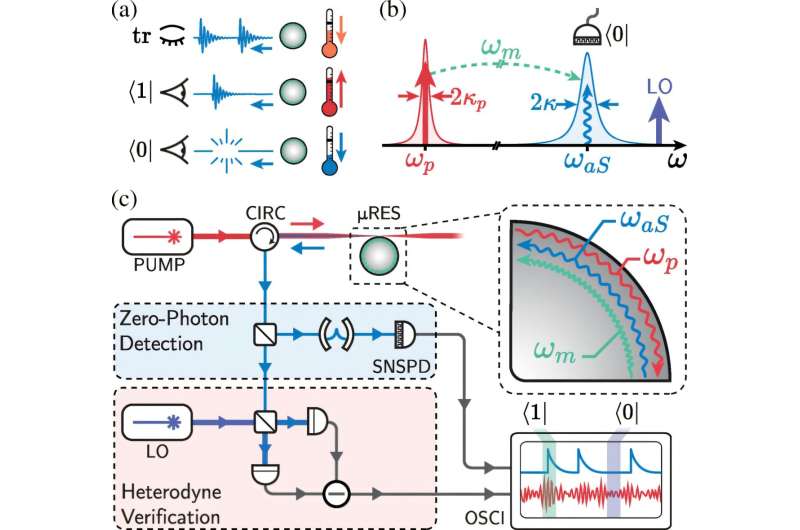This article has been reviewed according to Science X's editorial process and policies. Editors have highlighted the following attributes while ensuring the content's credibility:
fact-checked
peer-reviewed publication
trusted source
proofread
Can measuring nothing … do something? Cooling vibrations with zero-photon detection

Experiments coupling light and sound reveal the surprising effect that measuring nothing can cool the vibrations of an object.
We use measurements to understand the world around us. With our eyes and ears, we constantly infer the state of our surroundings through the sights and sounds that reach us, allowing us to navigate our daily lives. While these "measurements" often focus on observing the presence of something, the absence of something also provides valuable information.
Researchers spanning Imperial College London, the University of Oxford, the University of Waterloo, the University of Leeds, and the University of Copenhagen have used the absence of scattered light to cool the motion of a tiny glass bead below room temperature.
Alongside their experimental demonstration, they developed a mathematical model to describe the effect, and their results are published as a pair of contributions in the journals Physical Review Letters and Physical Review A.
To implement their research, the team used a glass microsphere—only four times wider than a human hair—that traps both light and high-frequency sound waves by continually reflecting them around its circumference.
Named after the Whispering Gallery in St Paul's Cathedral where this effect was first explained, these "whispering-gallery-mode resonators" confine the light and sound long enough for them to interact with one another, correlating the two waves. Subsequent measurements of the light leaving the glass bead then provide information about the sound wave.
Using single-photon detectors, the researchers were able to determine whether one or no photons had been scattered by the sound wave at each moment in time. Then, by considering only the times where no photons were detected, the team observed with an independent measurement that the sound waves circling the bead were quieter than usual; when a single photon was detected instead, they were louder.
"This result was certainly surprising at first," says co-first author Evan Cryer-Jenkins from the Quantum Measurement Lab at Imperial College London. "However, it makes sense, as the light and sound are correlated in our experiment, so the information gained from the measurement enables the state of the sound wave to be further cooled."
Co-first author Jack Clarke, also from the Quantum Measurement Lab, adds, "While it seems counterintuitive at first, updating our knowledge about the world after noticing something isn't there is actually something we do every day. Whether it's checking for rain or realizing you've misplaced your keys, noticing absence is often as telling as presence."
Utilizing laser light to cool objects is a powerful technique that is applicable to many systems, including trapped atoms and ions. Here, the team builds on these techniques and shows how to go beyond conventional laser cooling limits by utilizing measurement.
"Quantum measurement is a fascinating subject and I'm sure there are further discoveries to be made ahead," says co-first author Arjun Gupta from the Quantum Measurement Lab.
"Using zero-photon detection to help cool quantum systems into their ground state will help with the development of quantum computers and quantum networks, as well as testing the fundamental laws of physics," says co-first author Kyle Major from the Quantum Measurement Lab, further noting, "it was great to see the arXiv preprint of our research be picked up by New Scientist and make it as a subtitle on the cover of the print magazine."
"These results are an exciting milestone for our team and provide a powerful new technique to control quantum systems. We're thrilled to see how zero-photon detection will help the work of our lab and the wider scientific community," says Michael R. Vanner, Principal Investigator of the Quantum Measurement Lab at Imperial College London.
More information: Evan A. Cryer-Jenkins et al, Enhanced Laser Cooling of a Mechanical Resonator via Zero-Photon Detection, Physical Review Letters (2025). DOI: 10.1103/PhysRevLett.134.073601
Jack Clarke et al, Theoretical framework for enhancing or enabling cooling of a mechanical resonator via the anti-Stokes or Stokes interaction and zero-photon detection, Physical Review A (2025). DOI: 10.1103/PhysRevA.111.023516
Evan A. Cryer-Jenkins et al, Something from Nothing: Enhanced Laser Cooling of a Mechanical Resonator via Zero-Photon Detection, arXiv (2024). DOI: 10.48550/arxiv.2408.01734
Jack Clarke et al, Something from Nothing: A Theoretical Framework for Enhancing or Enabling Cooling of a Mechanical Resonator via the anti-Stokes or Stokes Interaction and Zero-Photon Detection, arXiv (2024). DOI: 10.48550/arxiv.2408.01735
Journal information: Physical Review A , Physical Review Letters , arXiv
Provided by Imperial College London



















